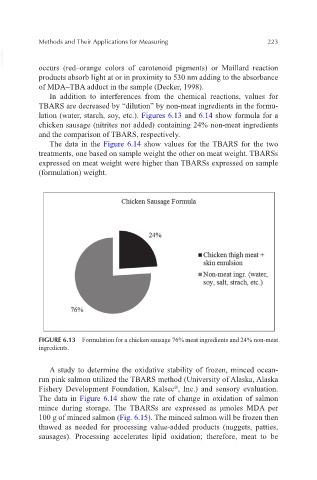Page 244 - Natural Antioxidants, Applications in Foods of Animal Origin
P. 244
Methods and Their Applications for Measuring 223
VetBooks.ir occurs (red–orange colors of carotenoid pigments) or Maillard reaction
products absorb light at or in proximity to 530 nm adding to the absorbance
of MDA–TBA adduct in the sample (Decker, 1998).
In addition to interferences from the chemical reactions, values for
TBARS are decreased by “dilution” by non-meat ingredients in the formu-
lation (water, starch, soy, etc.). Figures 6.13 and 6.14 show formula for a
chicken sausage (nitrites not added) containing 24% non-meat ingredients
and the comparison of TBARS, respectively.
The data in the Figure 6.14 show values for the TBARS for the two
treatments, one based on sample weight the other on meat weight. TBARSs
expressed on meat weight were higher than TBARSs expressed on sample
(formulation) weight.
Chicken Sausage Formula
• Chicken thigh meat +
skin emulsion
• Non-meat ingr. (water,
soy, salt, strach, etc.)
FIGURE 6.13 Formulation for a chicken sausage 76% meat ingredients and 24% non-meat
ingredients.
A study to determine the oxidative stability of frozen, minced ocean-
run pink salmon utilized the TBARS method (University of Alaska, Alaska
Fishery Development Foundation, Kalsec , Inc.) and sensory evaluation.
®
The data in Figure 6.14 show the rate of change in oxidation of salmon
mince during storage. The TBARSs are expressed as μmoles MDA per
100 g of minced salmon (Fig. 6.15). The minced salmon will be frozen then
thawed as needed for processing value-added products (nuggets, patties,
sausages). Processing accelerates lipid oxidation; therefore, meat to be

